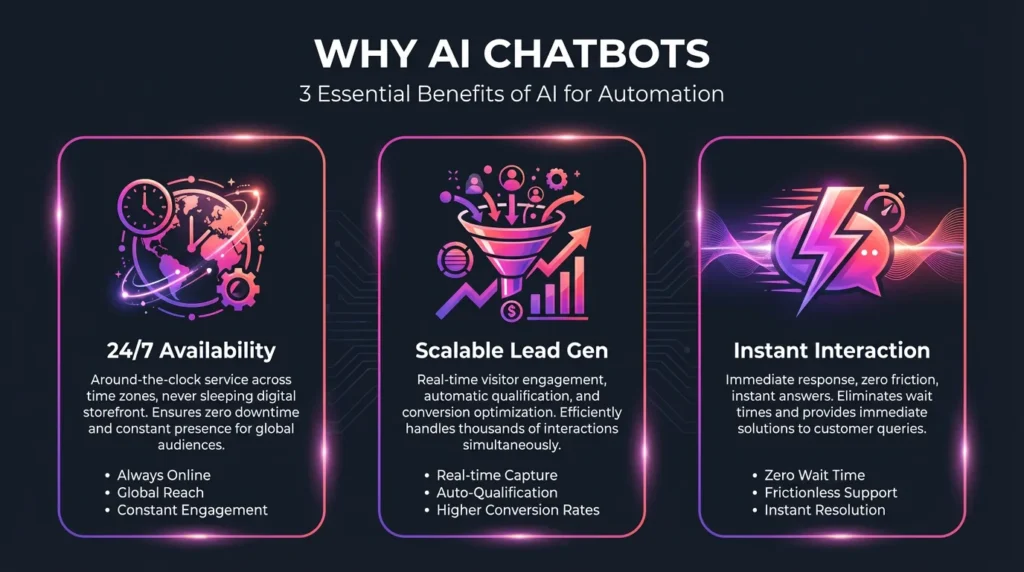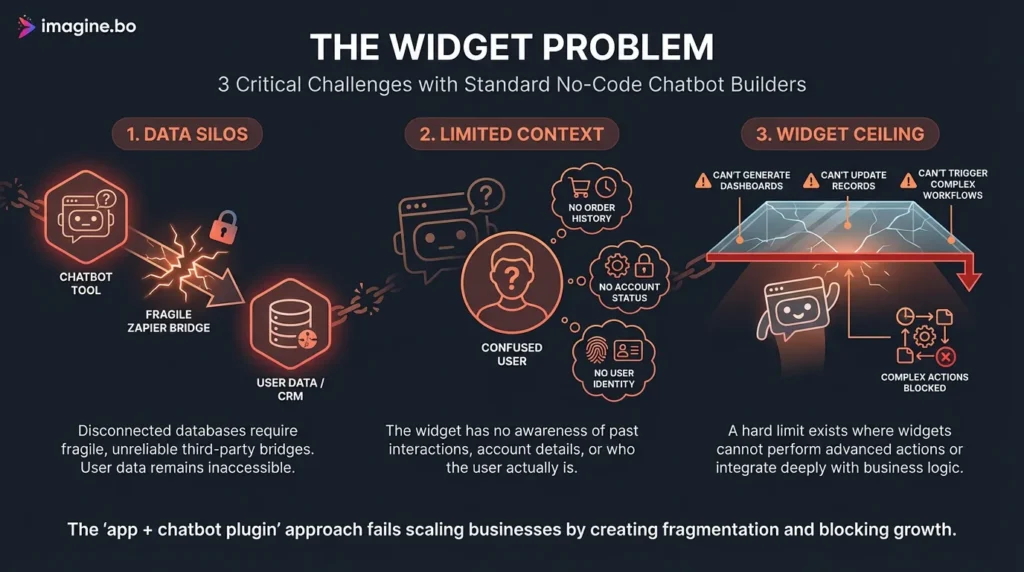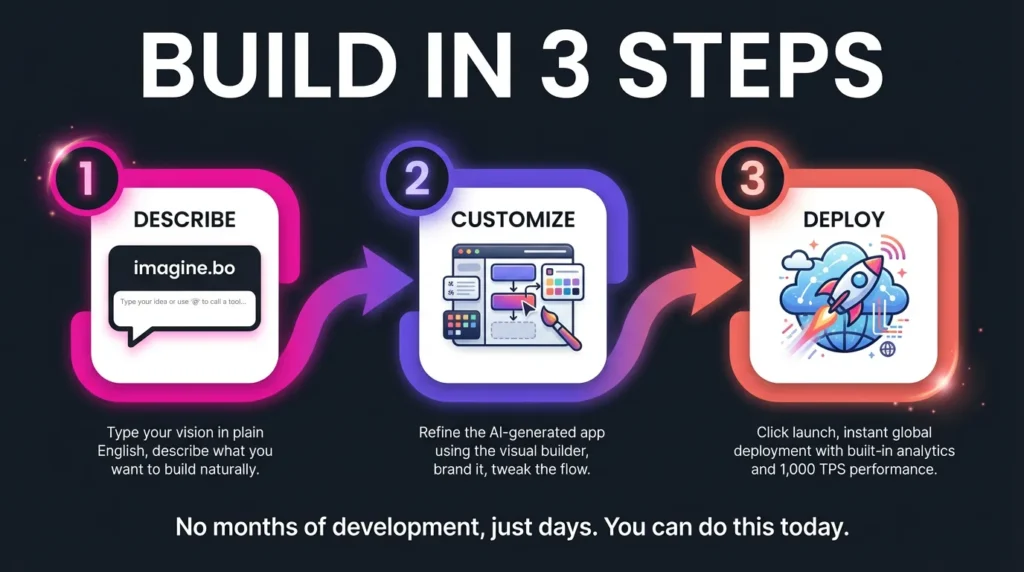The era of “gluing” simple chatbots onto static websites is ending. For founders and innovators today, the goal isn’t just a support widget—it’s intelligent, autonomous functionality that permeates your entire product. While adding AI chatbots to no-code platforms for enhanced user interaction and automation is a critical first step, the market has shifted. You no longer need to choose between hiring expensive engineering teams or settling for limited, “cookie-cutter” templates.
We are witnessing a massive transition from patching holes with widgets to building AI-native applications from the ground up. This guide explores why the old method of “app + chatbot plugin” is failing scaling businesses, and how new platforms like Imagine.bo allow you to build fully custom, enterprise-grade AI solutions without writing a line of code.
Launch Your App Today
Ready to launch? Skip the tech stress. Describe, Build, Launch in three simple steps.
BuildWhy AI Chatbots are Essential for Automation

Before we dismantle the old way of doing things, let’s acknowledge why the demand for AI is exploding. Whether you are building a SaaS MVP, a customer support portal, or an internal data tool, AI offers three non-negotiable benefits:
- 24/7 Availability: Your digital storefront never sleeps. AI agents handle inquiries, bookings, and troubleshooting instantly, regardless of time zones.
- Scalable Lead Gen: Unlike static forms, AI engages visitors in real-time, qualifying leads and guiding them through complex sales funnels automatically.
- Instant User Interaction: Modern users demand immediacy. Friction kills conversion, and AI removes friction by answering questions the moment they arise.
However, realizing these benefits depends entirely on how you implement the technology.
The Challenge with Standard No-Code Chatbot Builders

If you have looked at the current landscape—tools like Chatling, WotNot, or Landbot—you’ve likely noticed a pattern. These platforms are excellent at one specific thing: creating a widget.
You build a flow, you get a snippet of code, and you paste it into the corner of your existing website. This approach creates a critical problem known as Tech Stack Fragmentation.
- The Data Silo: Your chatbot lives in one tool, while your user database lives in another (like Airtable or Bubble). Getting them to talk to each other often requires complex “glue” tools like Zapier, which adds cost, latency, and fragility.
- Limited Context: A widget rarely knows who the user is. It doesn’t know their order history or account status unless you hire a developer to build custom API bridges.
- The “Widget” Ceiling: Eventually, you will want your AI to do more than chat. You’ll want it to generate dashboards, update records, or trigger complex workflows. Standard chatbot builders hit a hard ceiling here because they aren’t apps—they are just overlays.
The Better Solution – Building AI-Native Apps with Imagine.bo
Why struggle with adding AI chatbots to no-code platforms as an afterthought when you can generate a fully functional, AI-powered application from day one?
Imagine.bo represents the next generation of no-code. It isn’t a chatbot builder; it is an AI-powered app architect. Instead of giving you a template to tweak, Imagine.bo builds the entire stack for you—database, frontend, backend logic, and AI integration—customized to your exact needs.
Key Features That Change the Game
- Text-to-App Generation: You don’t drag-and-drop until your hand hurts. You simply describe your idea using Text-to-App: “I want a customer support portal where users can log in to view their tickets, and an AI agent that automatically suggests solutions based on our knowledge base.” Imagine.bo writes the code and builds the architecture in minutes.
- Enterprise-Grade Infrastructure: Unlike flimsy plugin bots, apps built on Imagine.bo are deployed on AWS or Google Cloud (GCP). They are SOC2 ready and GDPR compliant out of the box, meaning you can sell to enterprise clients without fear.
- The “Unstuck” Guarantee: The biggest fear in no-code is hitting a wall. Imagine.bo features a unique “Assign to Real Developer” button. If the AI reaches its limit on a complex feature, a human engineer steps in to build that specific component for you.
Step-by-Step Guide: How to Build with Imagine.bo

Building a custom AI application is no longer a multi-month project. Here is the 3-step workflow to launch your MVP this week:
1. Describe Your Vision
Forget complex requirement documents. Type your idea into Imagine.bo in plain English.
- Example: “Build a CRM for real estate agents with an integrated AI chatbot that schedules viewings and syncs them to a calendar.”
2. Customize Visually
Once the AI generates your base application, use the intuitive visual builder to refine the look and feel.
- Refine the Flow: Tweak how the AI interacts with users.
- Brand It: Upload your assets and adjust the UI to match your brand identity.
- Connect Data: Watch as the AI automatically structures your database relationships.
3. Deploy and Scale
Click “Launch.” Your app is instantly deployed to a global cloud network with built-in SEO optimization and analytics.
- Performance: Imagine.bo guarantees 1,000 transactions per second (TPS), ensuring your app won’t crash even if you go viral on launch day.
- Iterate: Need a new feature next month? Just ask the AI to add it.
Comparison: Why Founders Choose Imagine.bo
| Feature | Traditional Development | Standard No-Code (Zapier + Widgets) | The Imagine.bo Way |
|---|---|---|---|
| Time to Launch | 3-6 Months | 2-4 Weeks | Days |
| Cost | $15k – $100k+ | $500/mo (Multiple Subscriptions) | Affordable Flat Rate |
| Scalability | High | Low (Breaks at scale) | Enterprise (1,000 TPS) |
| Customization | Unlimited | Limited by Template | Unlimited (AI + Human Fallback) |
| Maintenance | Hiring Devs | Constant “Zap” Fixing | Automated |
The Verdict: Traditional no-code is like buying a pre-fabricated shed. It’s quick, but you can’t turn it into a house. Imagine.bo acts as an architect and construction crew, building a custom skyscraper on a solid foundation.
Conclusion
The conversation has moved beyond simply adding AI chatbots to no-code platforms. In 2025, successful founders are building AI-native applications that are robust, scalable, and fully integrated.
You don’t need a technical co-founder, and you certainly don’t need to patch together five different tools to get your idea off the ground. You just need the right platform.
Don’t just dream it, Imagine it.
Ready to build your fully custom AI application? Join the Imagine.bo Waitlist today and get Early Access to the future of software development.
Launch Your App Today
Ready to launch? Skip the tech stress. Describe, Build, Launch in three simple steps.
Build




